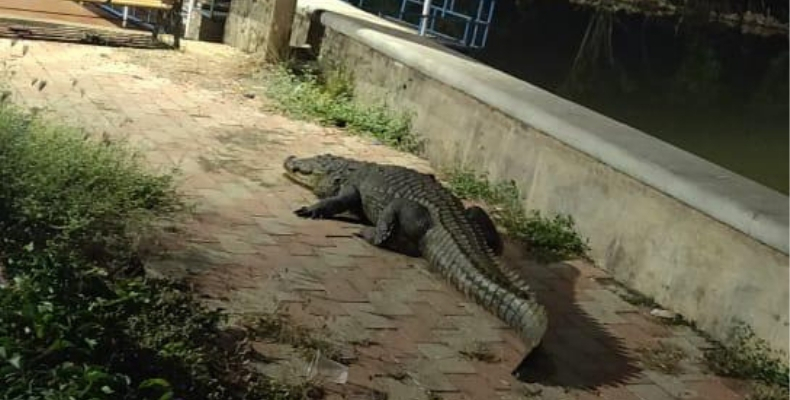Crocodiles are large, aquatic reptiles that are native to the tropical regions of Africa, Asia, the Americas, and Australia. In Goa, they can be seen in the narrow Cumbharjua canal, sunning themselves along the muddy banks of this inlet. This canal also serves as a connection between Goa’s two biggest rivers, the Mandovi and Zuari. Which probably explains how the Torda creek had a visitor late last night. That’s right, a crocodile was spotted taking a stroll along the road that runs beside the creek in the wee hours of the night.
It’s important to note that while the crocodiles we see in Goa are freshwater crocodiles, the Torda creek’s visitor seems to be part of the saltwater species, making it a major surprise for those that witnessed its late-night visit to the creek.
Crocodiles have a place in Goa’s history
History mentions that crocodiles were introduced into the Cumbharjua canal by Adil Shah in the 1500s. Adil Shah was believed to have used them as a part of his ‘naval warfare’ strategy. Some historical accounts say they were used as a last resort to prevent Afonso de Albuquerque and the Portuguese empire from taking over his territories.
According to one story, crocodile played a major role in the battle over the Banastarim fort. They were placed in the moat and therefore if any enemy soldiers that walked on the bridge leading to the fort were gunned down, they became food for the crocodiles lying in wait.
Goa’s freshwater crocodile species
In some places, there is a unique eco-theological ritual of crocodile worship known as mannge thapnee in Konkani. It is practiced by only a few people from the farming and fishing communities. This ritual of mannge thapnee is celebrated in Durbhat every year on Paush Amavasya in the Hindu calendar, which corresponds to the first new moon day in January. This year, it was done on the 10th of January.
As a general rule, the freshwater or ‘Mugger’ crocodiles in the Cumbharjua canal are relatively harmless, unlike their saltwater relatives that tend to prey on livestock and even humans in some cases. That being said, while there haven’t been any instances of humans being killed by these Mugger crocodiles, it’s still best to avoid their habitat given that they are still carnivorous to some degree.
There aren’t a lot of crocodiles left in the Cumbharjua canal. Their estimated numbers are believed to be between 40-50 landing them a place on the endangered species list. This is also because, their environment, which happens to be Goa’s famed mangroves, has been threatened thanks to human interference and massive development. Therefore, no matter how many rituals are performed, it still remains to be seen if Goa can save these remaining descendants of the dinosaurs.
Check out the below link for safety information when it comes to encountering crocodiles
http://www.crocodile-attack.info/about/safety-information
Information credit
https://www.dnaindia.com/india/report-goa-s-warrior-crocodiles-fight-battle-for-survival-1126935
https://www.livemint.com/Politics/XT3XAh4KoIjxWqOY4dgwcO/A-prayer-for-the-crocodile.html
ItsGoa/JAN/KDGP


